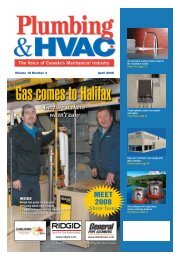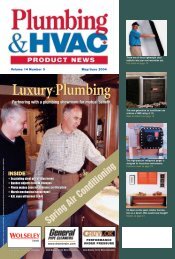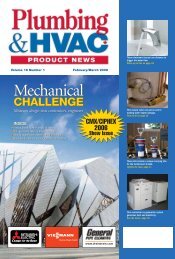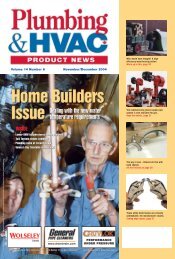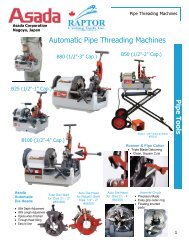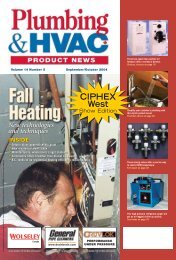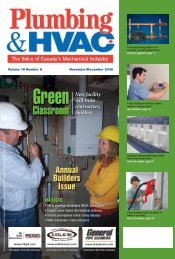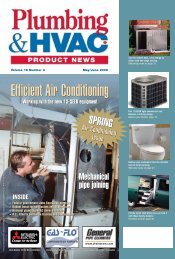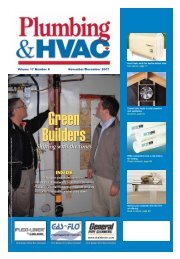CMX 2004 - Plumbing & HVAC
CMX 2004 - Plumbing & HVAC
CMX 2004 - Plumbing & HVAC
Create successful ePaper yourself
Turn your PDF publications into a flip-book with our unique Google optimized e-Paper software.
Shop Management<br />
Develop a financial<br />
structure that works<br />
Our business guru crunches the numbers<br />
By Ron Coleman<br />
Many contractors<br />
have difficulty<br />
understanding<br />
what<br />
their financial<br />
structure should<br />
look like. That<br />
may not be too<br />
surprising,<br />
given that it is different for each segment<br />
of the industry. Even within segments<br />
there are major differences<br />
depending on size and work mix.<br />
The following commentary is based<br />
on a survey of 25 members of the Heating,<br />
Refrigeration and Air Conditioning<br />
Contractors (HRAC) Association of<br />
Canada. The average company had sales<br />
of $1.27 million, with no company over<br />
$2 million. There is a combination of<br />
service and contracting work. We have<br />
not established what that mix is. The<br />
contractors are based across Canada,<br />
with most of them in Ontario.<br />
This particular group of contractors<br />
shows pre-tax profits at 5.7 percent,<br />
which is almost 50 percent higher than<br />
the average North American contractor<br />
in this market segment.<br />
The issues that we will explore are:<br />
• What is the typical overhead structure<br />
of these companies?<br />
• What is the level of break-even<br />
sales required to operate them?<br />
• How to reduce the level of breakeven<br />
sales and …<br />
• What is the capital structure of<br />
these companies?<br />
The following table shows the average<br />
overhead structure:<br />
Income Statement<br />
Average of 25 companies<br />
$1000s<br />
Total Sales 1270 100.0%<br />
Job Costs<br />
Materials 565 44.5%<br />
direct labour 216 17.0%<br />
Subs & other direct 16 1.3%<br />
TOTAL DIRECT 797 62.8%<br />
Gross Profit 473 37.2%<br />
Overhead<br />
Salaries* 196 15.4%<br />
Advertising & promotion 23 1.8%<br />
Vehicles 44 3.5%<br />
Depreciation 22 1.7%<br />
Insurance 15 1.2%<br />
Occupancy 28 2.2%<br />
Office and admin 59 4.6%<br />
Repairs, shop supplies etc 13 1.0%<br />
400 31.5%<br />
Net Profit 73 5.7%<br />
Note: Salaries include owner/manager at<br />
$75,000 per annum<br />
make a real impact on them. Most of<br />
them are virtually fixed.<br />
If you can’t do much to lower your<br />
overhead there are only three things you<br />
can do to make more profit – increase<br />
volume, increase selling price or improve<br />
productivity.<br />
However, a volume increase means<br />
more cost, while the other two options<br />
are 100% profit. Going for volume often<br />
means lower selling prices, expensive<br />
marketing, poorer productivity and<br />
higher overhead. So, it makes sense to<br />
focus on selling price and productivity.<br />
Increasing efficiency or increasing<br />
your selling price has the biggest impact.<br />
Your gross profit percent will<br />
increase.<br />
Your break-even sales number is calculated<br />
by dividing your overhead by<br />
your gross profit percent. Lowering<br />
your overhead or increasing your gross<br />
profit reduces the amount of sales you<br />
need to break even.<br />
You will see from the table that by<br />
increasing your gross margin from<br />
37.2% of sales to 44% of sales that your<br />
additional profit is $164,905, or the<br />
amount you need to break-even is<br />
$164,905 less. You should be easily able<br />
to generate this increase in percentage<br />
by a combination of increased pricing<br />
and improved productivity.<br />
A typical balance sheet looks like this:<br />
Balance Sheet<br />
Average of 25 companies<br />
Current assets $1000s<br />
Cash 70<br />
Receivables 121<br />
Inventory 113<br />
Other 12<br />
316<br />
Capital (Fixed) assets<br />
Vehicles & Equipment, at cost 284<br />
Depreciation -173<br />
Net capital assets 111<br />
Total assets 427<br />
Current liabilities<br />
Accounts payable 112<br />
Bank debt 34<br />
Other current 30<br />
176<br />
Term debt 40<br />
If you lease your vehicles<br />
Break-even table<br />
rather than buying<br />
them, your cash outgoings<br />
Overhead $400,000 $400,000 $400,000<br />
will be higher and<br />
Gross profit 37.2% 40.0% 44.0% your investment lower.<br />
It is very difficult to reduce your Break-even sales $1,073,996 $1,000,000 $909,091 On average these companies<br />
are turning over<br />
overhead. Overhead represents a relatively<br />
small percent of sales and, as you<br />
their working capital at a<br />
Additional profit $164,905<br />
can see, it is difficult to cut back. The<br />
rate of almost ten times a year.<br />
only area of significance that you could Capital structure<br />
Working capital is the net of the current<br />
reduce would be to reduce overhead So, if you want to set up a company like<br />
assets and current liabilities<br />
salaries. When you look at your own this, you need to put some money ($316,000-$176,000 = $140,000).<br />
numbers, you will realize how difficult together.<br />
Annual sales are $1,270,000. Divide<br />
this really is.<br />
You need to buy or lease vehicles, working capital into sales and in this<br />
In our sample we are showing overhead<br />
equipment and tools. You need to instance you get 9.2 turns a year. On this<br />
of $400,000 with almost half of finance the activities such as the inven-<br />
basis you need to provide approximate-<br />
that in salaries. The rest is spread over tory and the receivables and you must ly 10% of your expected sales in working<br />
so many categories that it is difficult to meet the payroll.<br />
capital for your business. That is the<br />
money to operate the business, excluding<br />
Why is this man smiling? the money for fixed assets. This is<br />
money that you have to provide.<br />
Our average owner has invested<br />
Reason<br />
$211,000 in his company, or approximately<br />
$1 in investment for every $1 in<br />
#7<br />
debt. These companies are very well<br />
financed. This $211,000 is (broadly<br />
Member Advantage<br />
speaking) providing $140,000 in working<br />
capital and $51,000 for fixed (capi-<br />
Programs<br />
HRAC membership means this man's<br />
tal) assets.<br />
company enjoys access to a variety of<br />
If you start up a new business,<br />
groupdiscount programs. Savings on<br />
remember that it is going to take up to<br />
vehicle leasing, business supplies, fuel for<br />
three years before you can turn a profit<br />
his company's trucks and Visa Merchant<br />
fees will more than pay for his company's<br />
and take a full salary. Many business<br />
membership. These are only a few of the<br />
owners run out of money before they<br />
saving programs offered by HRAC.<br />
have given the company a real chance to<br />
So, why is this man smiling?<br />
survive.<br />
For many start-up businesses the<br />
growth has to be financed by profits. So,<br />
Because his company is a<br />
unless you start off making money you<br />
member of HRAC.<br />
will never be able to finance your<br />
You should be to!<br />
growth.<br />
Ronald Coleman is an accountant,<br />
business management consultant, author<br />
and educator specializing in the construction<br />
1-800-267-2231 www.hrai.ca/hrac.html<br />
industry. He can be reached at<br />
rcoleman@coleman.bc.ca.<br />
Circle Number 175 for More Information<br />
Circle Number 176 for More Information<br />
70 <strong>Plumbing</strong> & <strong>HVAC</strong> Product News – March/April <strong>2004</strong> www.plumbingandhvac.ca<br />
Total debt<br />
Owner's investment 211<br />
Total liabilities and investment 427




